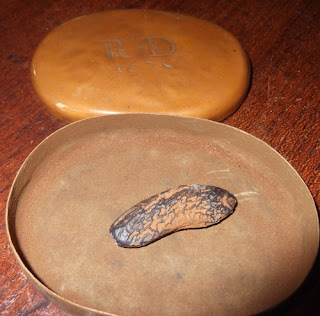Monday, 17 June 2013
Monday.
Another Mystery Object - and this time it's a stinker!
A copper box and its lid are photographed above. The box was originally made, I should think, as a tobacco box. It is about four and a half inches long. When I first acquired the box (in 1975) it had been used as a snuff box for many years. It also had in it the wrinkled object, which is, of course, the MYSTERY OBJECT. It is just over an inch long; and NO, before Rog, Sir B., or Crowbar make the suggestion, it is not (despite its wrinkled appearance) any superfluous part of your blogger which has dropped off due to age or disuse (sorry ladies - but you know what they're like, and, of course, I shouldn't encourage them).
The object does serve a purpose, and has two names. If any of you know the answer, I shall be pleasantly surprised - with the possible exception of Brother Crowbar, the breadth of whose knowledge (even after nearly seventy years) can still occasionally surprise me. I think he should try for both common names, AND the Linnaean one perhaps.
Subscribe to:
Post Comments (Atom)

17 comments:
Is it used in the tanning process? For scraping or smoothing the leather possibly?
By the way, I was really upset that you couldn't get over to see Ruthie, although I am not surprised the doc said no.
Love to you both Maggiexxx
Would that by any chance be Great Uncle George's original Hog-bean, as offered to young Dave (Ann's middle brother) at a funeral long since?
Sheer guess mind you!
Hi Maggie. No.
Thank you, it was a bit of a jar- but I know the vet was right really.
Love, Mike.
Would that be Great Uncle George Smart's hog-bean as proffered to Young Dave, Ann's middle brother at a funeral several decades since? Just a wild guess mind you!
I understand a vegetable such as a bean or a small potato were kept in tobacco boxes to maintain humidity and prevent the baccy from getting too dry.
After some thought I believe the hog-bean is also known as white henbane, and like the potato it is the tuber which maintains humidity. If I am right the Linean homonym is Hyoscyamus albus. Other Synonyms are:-Common Henbane. Hyoscyamus. Hog's-bean. Jupiter's-bean. Symphonica. Cassilata. Cassilago. Deus Caballinus.
(Anglo-Saxon) Henbell.
(French) Jusquiame.
Is it a scarab beetle?
Dear Maggie and Crowbard, the answer, so far, is NO. I'll leave it till later before enlightening you, as others may like to try it. Please keep trying though if any more ideas occur.
Is it something to do with processing Yarns?
(Much like your blog of course)
Sorry Rog. No. So far Crowbard is nearest, but only in so far as it is a bean.
You ruled out my first thought in the text of your post. It is a bean you say? My next thought was that it was in the tin to, perhaps, prevent the snuff from clumping together. Real shot in the dark, that one. If I'm totally honest, I'm stumped.
Hello Sir B. I think we can say you've got it - the nearest yet anyway. It's a Tonka bean, or a Tonquin bean, the seed of the Dipteryx Odorata (old genus name - Coumarouna), a Papilionaceous tree of Guina. It was used for scenting snuff, usually carried in a snuff box of plain snuff. It has a scent not unlike vanilla, but stronger and spicier. It also, as you suggest, is supposed to have kept the snuff drier, and therefore prevented it 'clumping'. But the main purpose was to add an interesting scent to the snuff (which it still does).
P.s. Sorry - Guiana, I think.
P.P.s. That's why I gave you the strong clue - "It's a stinker".
So is the clue really.
Sometimes, I amaze even myself! Didn't pick up on the scent clue, so I feel half marks would be appropriate. Going off to sit quietly and feel smug now.......
Congratulations Sir B., I had never heard of the Dipteryx odorata although the Tonka bean is ringing vague and distant bells; whereas great uncle George's predilection for Hog-beans is in all the local history books...
Isaw the tonka bean mentioned in an article on cookery recently (in, I think, a Saturday Telegraph supplement). This reminded me that I had one somewhere in an old snuffbox, which I then illustrated. Ann thinks she has a small packet of tonka beans which she bought in a spice shop in Cambridge in the sixties. Having looked them up on Goodle (hence the Linnaean name) I found their use recommended in cookery vide the Telegraph article. But Google recommended very sparing use of them, as they're slightly toxic in some directions (No-nor-west probably, like Lear ?). The one in the old snuff box smells subtly delicious, but in view of the foregoing remarks I'd check them out carefully before using them in cookery.
Post a Comment